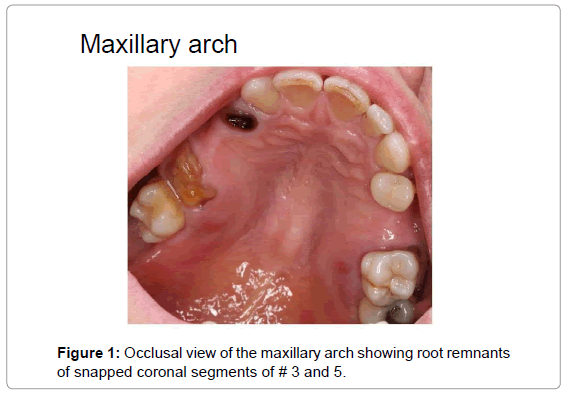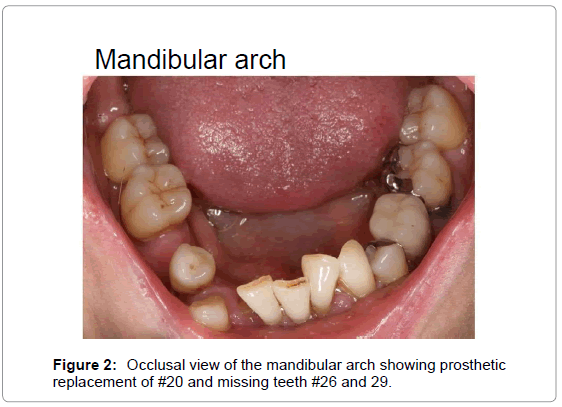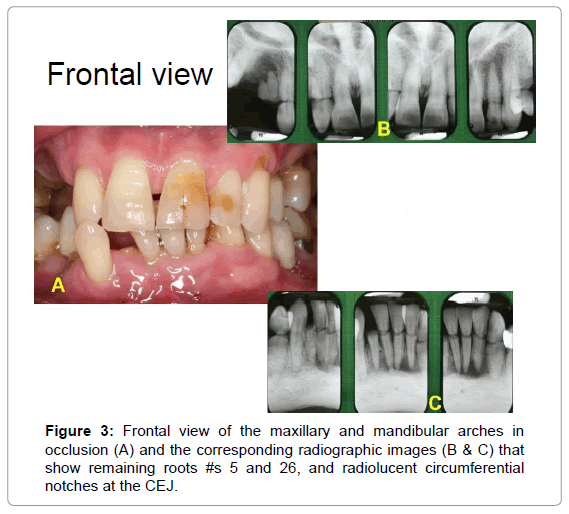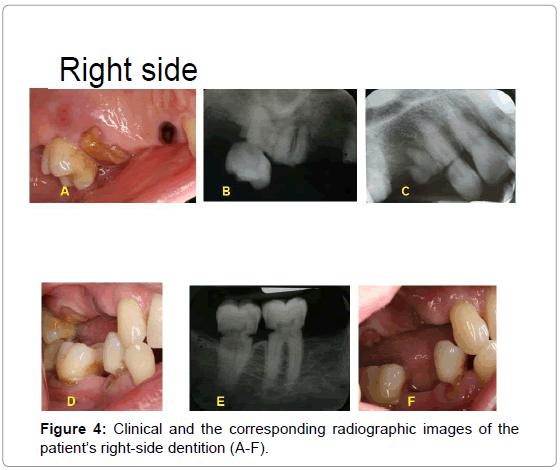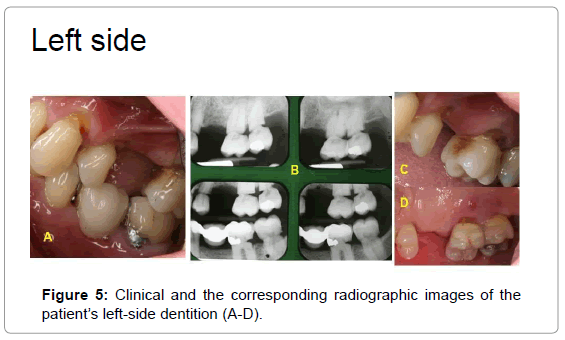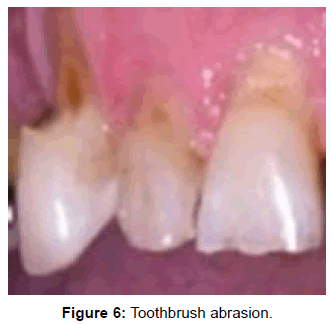Case Report Open Access
Tooth Surface Loss Associated With Oral Home Care Devices: A Case Report
Mohamed A. Bassiouny*
Professor of Restorative Dentistry, Temple University School of Dentistry, Philadelphia, USA
- *Corresponding Author:
- Mohamed A. Bassiouny
Professor of Restorative Dentistry
Temple University School of Dentistry
Philadelphia, USA
Tel: 2157077747
E-mail: mbassiouny@dental.temple.edu
Received Date: September 27, 2014; Accepted Date: October 30, 2014; Published Date: October 31, 2014
Citation: Bassiouny MA (2014) Tooth Surface Loss Associated With Oral Home Care Devices: A Case Report. J Oral Hyg Health 2:165. doi:10.4172/2332-0702.1000165
Copyright: © 2014 Bassiouny MA, et al. This is an open-access article distributed under the terms of the Creative Commons Attribution License, which permits unrestricted use, distribution, and reproduction in any medium, provided the original author and source are credited.
Visit for more related articles at Journal of Oral Hygiene & Health
Abstract
Universal consensus affirms the role of dental plaque as the single most significant etiology of dental caries and gingivitis. To prevent the occurrence of these destructive diseases, the removal of plaque by mechanical devices is employed with profound effect. Toothbrush and interdental cleansing devices such as dental floss are predominantly used for this purpose. However, serious damage to the dentition may result from the misuse of these tools. This report portrays this type of damage that is manifested as severe dental abrasion of the entire circumference of root trunks of a dentition. This condition was developed by improper use of the aforementioned devices aggressively for three decades. The resultant damage serves as a sober reminder of what not to do when performing oral home care. This report also highlights the importance of adopting a proper oral hygiene protocol following professional instructions.
Keywords
Dental floss; Toothbrush; Tooth surface loss; prevention
Introduction
Evidence from clinical research indicates that there is a significant relationship between microbial dental plaque and periodontal disease [1-3]. Epidemiologic data suggests the association of chronic gingivitis and bacterial plaque adhering to tooth surface [4-6]. Clinical and invivo studies have demonstrated the occurrence of metabolic events by the microbial dental plaque in the presence of dietary carbohydrates [5-11]. These events result in the fluctuation of plaque fluid pH that changes the dynamic equilibrium in-situ and leads to dissolution of enamel minerals, a precursor of dental caries formation [7-10]. It was also reported that caries failed to develop with frequent additions of sucrose to the diet in the absence of plaque [11]. These irrefutable findings provided in the literature have pointed out the causative relationship of bacterial dental plaque and both caries and periodontal disease [1-11]. These destructive dental diseases are responsible for loss of teeth in populations in many modern societies as they have plagued the populations throughout the world, for centuries [12].
In order to limit the predominance of caries and periodontal diseases on a public scale, the preventive approach outweighs treatment as the best choice for socio-economic reasons and availability of human resources. Because plaque is a significant factor in the etiology of these destructive dental diseases, its efficient removal constitutes the principle strategy of the preventive approach [2,5,13]. In support of this hypothesis are the positive correlations between the degree of oral hygiene and the frequencies of marginal gingivitis as well as caries [13,14]. The universally used dental hygiene device for cleaning dentition is the toothbrush. This device manifested its effectiveness in plaque removal as a chief aid of prevention of periodontal disease, although its effectiveness in caries prevention is arguably less convincing [14-22]. This argument pivots on the limitation of tooth brushing to remove bacterial dental plaque off the entire interproximal surfaces of the dentition, particularly in areas cervical to proximal contacts that are vulnerable to caries [21,22]. It is, therefore, recommended to supplement tooth-brushing with interdental cleaning device such as dental floss to remove plaque from these sites [23-27]. If these oral hygiene devices are used properly according to professional instructions, maximum efficacy may be achieved and potential pitfalls associated with their misuse might be avoided [28].
Objective
The purpose of this report is to highlight the detrimental effects on the dentition that resulted from misusing dental floss that was employed in conjunction with improper tooth brushing technique for a prolonged duration.
Case Report
This report presents iatrogenic loss of several coronal segments of an adult female dentition that was neither subjected to trauma nor has suffered from extensive caries or advanced periodontal disease. She has, however, zealously practiced a daily oral hygiene routine for more than thirty years using toothbrush and dental floss. This patient reported experiencing sensitivity and pain followed by loss of the coronal segments of an otherwise sound healthy dentition and peridontium. Clinical examination and the radiographic findings revealed the damage to the dentition that supported the patient’s dental health history and confirmed the causative etiology.
Dental health history
This 56 year-old Caucasian female, Italian born has migrated with her parents to the United States at the age of twelve. She was diagnosed with gingivitis in her early twenty and was advised to use a toothbrush and dental floss to remove dental plaque and soft deposits. In order to cure the gingivitis and prevent further recurrence of the disease, she has faithfully complied with the professional advice by implementing an oral hygiene regiment that she had presumed to be correct. According to her account, she used a hard bristle toothbrush complimented by thick un-waxed floss for cleaning her teeth. She would hold the toothbrush with a full fist grip and applied a horizontal brushing technique to clean the outer and inner surfaces of her teeth vigorously. This patient also reported inserting the floss through the distal contact of the tooth to be cleaned, wrap the floss around the lingual aspect then glide it through the mesial contact. Once the floss is wrapped around the tooth and secured under the gum margin, she pulled both ends of the floss alternatively in an aggressive sawing motion back and forth for about 10-20 strokes per tooth. This process was repeated for every tooth of the dentition. The daily routine of oral hygiene lasted about 45 minutes before retiring to bed, and continued for more than three decades. This patient suffered from a nocturnal bruxism. Her dietary history indicated the absence of highly acidic foods and beverages, and described herself as a “salt-a-holic” until she was diagnosed with hypertension five years ago that led to decreasing the salt intake.
Chief complaint
Eight years ago, this patient began to experience sensitivity during flossing that developed later into pain, which gradually worsened and often radiated to her ears nose and jaws. In her efforts to ameliorate these symptoms, she has substituted the thick un-waxed floss for thinner type and decreased the duration of her daily oral hygiene care from 45 minutes to 20 minutes. Concurrently, she began to experience loss of few coronal segments of her teeth that literally fell-out of her mouth, without any predisposing trauma. She had sought professional help to address the problem that resulted in extraction of remaining roots of the snapped-off crowns.
Initial clinical findings
This physically healthy patient, whose head and neck were normal, presented to have her teeth “fixed”. At first glance, her gingival condition appeared healthy with firm consistency, normal stippling contour and pink color without deepening of gingival pockets. Recession of facial gingiva of the molars regions of the two arches and the lower incisors segments as well as the palatal aspects of maxillary molars were evident. At the time of this evaluation, the patient already had all wisdom teeth extracted and also five teeth who had lost their coronal segments (two maxillary #s 4 and 13) and three mandibular (#s 20, 26 and 29). Her maxillary right lateral incisors were congenitally missing. The coronal segments of #s 3 and 5 were also missing, but their roots were clinically visible (Figure 1). Tooth #20 was replaced by a resin bonded porcelain fused to a metal bridge and teeth #s 2, 9, 10, 15 and 19 were restored (Figure 2). Slight extrinsic brown stains were found close to the gingival line of proximal surfaces of posterior teeth, occlusal pits and fissures and worn incisal edge of #24. These stains were superficial, easily removed and were found to be associated with excessive intake of black tea, according to the patient’s own dietary history. All coronal segments of the remaining teeth were intact, except for severe cervical wear at the facial aspects of the premolar-molar root trunks of both arches and mandibular anterior segments. These defects were extended approximately 3 millimeters axially and vertically with their coronal margins displaying abrupt sharp acute angles, while their apical borders had rather obtuse angles. The dentin walls of these facial defects were hard in consistency and maintained natural tissue color.
Radiographic findings
The radiographic images of this patient’s dentition disclosed multiple sharp triangular shaped radiolucent slits on the interproximal aspects of the root trunks just below the Cemento-Enamel-Junction. The majority of the remaining teeth in her dentition were affected apart from the two maxillary central incisors and the opposed inner proximal aspects of abutment teeth #19-21. These wedge-shaped defects were deep axially but narrow vertically and had well-defined borders with sharp lines of demarcation limiting the radiolucent defect from adjacent healthy radiopaque tooth structures (Figures 3-5). Variation among the axial depths and also the vertical heights of these defects were noted within the dentition. Some defects penetrated into the dentin walls about 2-3 mm, while others were more invasive. The radiographic images showed the remaining roots of teeth #s 3, 5, and 26 that had lost their coronal segments (Figures 3 and 4).
Revisiting clinical examination
In view of the radiographic findings, re-exploring the proximal walls of the dentition below the gingival margins with the explorer tip perpendicular to the tooth surface allowed for the discovery of these proximal defects. These defects were also found encircling the lingual circumference of the affected teeth. This finding confirmed the radiographic images. The proximo-lingual defects were entirely hidden below the free gingival line rendering them invisible by a casual glance. Superimposition of the radiolucent images of the lingual and facial defects formed distinct radiolucent bands that were clearly visible on the narrow-diameter mandibular anterior teeth (Figure 3). The resultant circumferential defects have left mushroom-like pedunculated crowns that became supported by thin stalks of strangulated dentin/pulp complex. These defects gave rise to a “carved apple core” image of the affected teeth. Progression of these circumferential defects has caused some crowns to succumb to normal stresses in the oral environment in addition to nocturnal bruxism, the condition that eventually led to snapping off the coronal segments. The lost coronal segments of teeth #s 3 and 26 (Figures 3 and 4) have left the occlusal ends of their remaining roots with “a clean cut” smooth profile.
Discussion
The case presented embodies the detrimental effects of incorrectly employing dental flossing combined with aggressive horizontal toothbrushing technique by a dental hygiene zealous individual for three decades. This patient was highly motivated to cure her gingivitis condition that was diagnosed thirty years ago and prevent further recurrence. Thus, she had faithfully executed the verbatim advice to clean her teeth daily by brushing and flossing using what she presumed to be the correct techniques. Meanwhile, she was totally unaware of the wrongful nature of the techniques employed and their consequential damage. The first manifestation of this damage was recognized eight years ago as dentin hypersensitivity, which later developed into pain and finally ended by loss of the coronal segments of several teeth that literally fell out of her mouth.
Prior to initiating the radiographic investigation for this patient, the clinical appearance of her dentition looked deceivingly normal, while the radiographic images disclosed multiple radiolucent defects involving the majority of root trunks at the crown junction. These findings were verified by revisiting the clinical examination. Axially exploration of the suspected regions under the gum margin allowed for the discovery of the defects, assessing their extents and identifying their etiologies. Because the floss-abrasion defects were inconspicuously hidden below the healthy free gingival margins of three surfaces, they eluded detection for years by casual examination. The circumferential facial-proximal-lingual defects gave a telltale of improper use of oral hygiene home care devices. Their features, locations, extents, configurations and distribution throughout the dentition clearly reflected the patient’s self-stated account of wrongful application of dental flossing and aggressive tooth-brushing for prolonged duration. Based on their location, configuration, condition of the adjacent gingival margins and the patient’s dental history, the facial defects were determined to be toothbrush abrasion wear associated with aggressive horizontal brushing using a hard bristle brush. This condition closely resample the case appears on Figure 6, which represents a classic advanced toothbrush wear of the maxillary anterior left segment. The absence of bacterial plaque deposits and the healthy abraded receded gingival margins at the affected sites further established the reported meticulous oral hygiene home care by this patient. Recent clinical studies on power brushing also confirmed the possibility of occurrence of these adverse effects [29,30]. The configuration of the interproximallingual slits with their clean machine-like cut, suggested a mechanically induced etiology. Their locations and involved aspects reflected the wear pattern by dental flossing that was employed by this patient. Thus, dental floss was the perpetrator for the proximo-lingual defects, while tooth-brushing was the culprit for facial abrasion defects. Poor prognosis was projected due to the extensive nature of damage to the dentition by these combined defects and the close location of tissue loss to the supporting alveolus.
The daily use of tooth-brushing combined with flossing or a substitute for inter-dental cleaning device are recommended by dental professionals to remove dental plaque from all aspects of the dentition, in order to maintain the integrity of the dental and periodontal health [17,20,24,28,31]. Since there is no single tooth-brushing technique suitable for universal use, varieties of techniques are advocated and specific ones are prescribed for individual use. Nonetheless, employing a horizontal brushing technique, especially on the facial aspects of the dentition, is greatly discouraged due to the potential adverse effect that can be manifested as toothbrush abrasion and gingival recession as illustrated by this case. These manifestations may be displayed in association with aggressive prolonged abuse of manual brushing and forceful application of power brushing. Therefore, selection of oral hygiene devices suitable for each individual use, proper professional instructions for their applications and faithful implementation of the correct techniques by patients are paramount [28]. Periodic clinical monitoring of the outcome and augmentation of the instructions are highly recommended. It is advocated that a soft bristle type of toothbrush is the proper selection to be used following the technique recommended by dental professionals for each individual. A recent clinical survey indicated that nearly all Americans brush their teeth, however, only 10-40% was reported to floss daily [32]. Reports suggest that if properly employed, tooth-brushing could clean almost two thirds of the tooth surface [2,22-27]. However, because tooth-brushing alone may not be sufficient to clean soft deposits off all surfaces of the dentition, its action should be reinforced by interdental cleansing. For this purpose, multiple devices are available such as: dental floss, superfloss, toothpick, solo-single tufted brush and interdental brush; the dental floss is the most universally used device due to its availability, low cost, ease of application and known efficacy [24-27]. Each of the aforementioned devices has its own specific application and proper method for use [28-31]. Noteworthy is that accidental injury to gingival tissue could be a frequent occurrence associated with misuse of dental floss, yet destruction to the entire dentition is a rare event, though highly probable, as reported by this case. Therefore, vigilant efforts should not be spared for the lookout of individuals with potential vulnerability of tissue damage and attempts are to be made to circumvent such irreversible damages.
The American Dental and Dental Hygiene Associations addressed the proper methods for using oral hygiene home care devices and in particular the recommended technique for proper flossing [33]. To promote a durable habit, it was also suggested to initiate flossing after tooth-brushing [34]. Universal precautions should be exercised such as avoiding sawing motion, slacking or snapping the dental floss through the contacts, and taking the necessary time to methodically implement the proper technique to clean all surfaces of the teeth at least once a day. In view of the reported mishaps and the likelihood of their occurrence, a tender reminder of a five-step protocol ought to be considered for each patient; 1) professional selection of oral hygiene care devices, 2) accurate description of the techniques of choice for their proper use must be clearly stated and demonstrated, 3) a warning of potential harm of improper use must be thoroughly explained, 4) reiterating instructions periodically for reinforcement [35], and 5) monitoring the patient’s dental and periodontal health periodically.
Concluding Remarks
This report focuses on the need for dental floss to compliment tooth-brushing and employing the proper techniques for both devices. It also presents a case that demonstrates the adverse effects of misusing these devices and recommends a five-step protocol for consideration, to avoid a similar calamity.
Acknowledgements
The insight on patient’s history and photographic illustrations provided by Steven S. Pesis DMD are gratefully acknowledged. 101314-10-3657/MAB.
References
- Loe H, Theilade E, Jensen SB (1965) EXPERIMENTAL GINGIVITIS IN MAN. J Periodontol 36: 177-187.
- Löe H (1969) Present day status and direction for future research on the etiology and prevention of periodontal disease. J Periodontol 40: 678-682.
- Bassiouny MA (1974) Dental Plaque and Prosthetic Appliances. Master Thesis presented to the Victoria University of Manchester, UK.
- lovdal A, Arno A, Waerhaug J (1958) Incidence of clinical manifestations of periodontal disease in light of oral hygiene and calculus formation. J Am Dent Assoc 56: 21-33.
- Axelsson P, Lindhe J (1974) The effect of a preventive programme on dental plaque, gingivitis and caries in schoolchildren. Results after one and two years. J Clin Periodontol 1: 126-138.
- Axelsson P, Lindhe J, Nyström B (1991) On the prevention of caries and periodontal disease. Results of a 15-year longitudinal study in adults. J Clin Periodontol 18: 182-189.
- Firestone AR, Muhlemann HR (1985) In vivo pH of plaque-covered and plaque-free interdental surfaces in humans following a sucrose rinse. Clin Prev Dent 7: 24-26.
- Von der Fehr FR, Löe H, Theilade E (1970) Experimental caries in man. Caries Res 4: 131-148.
- Thylstrup A, Bruun C, Holmen L (1994) In vivo caries models--mechanisms for caries initiation and arrestment. Adv Dent Res 8: 144-157.
- Burt BA, Pai S (2001) Sugar consumption and caries risk: a systematic review. J Dent Educ 65: 1017-1023.
- Loe H, Von Der Fehr FR, Schiott CR (1970) The effect of suppression of the oral microflora upon the development of dental caries. Cited from Loe H. 1970 “Detal plaque “A review of the prevention and control of plaque.
- Chen M, Anderson RM, Barmes DE, Leclerq MH, Lyttle SC (1997) Comparing oral health systems. A second international collaborative study. Geneva: World Health Organization.
- Beal JF, James PM, Bradnock G, Anderson RJ (1979) The relationship between dental cleanliness, dental caries incidence and gingival health. A longitudinal study. Br Dent J 146: 111-114.
- Bassiouny MA, Grant AA (1975) The toothbrush application of chlorhexidine. A clinical trial. Br Dent J 139: 323-327.
- Marthaler TM (1968) Caries-inhibition after seven years of unsupervised use of an amine fluoride dentifrice. Br Dent J 124: 510-515.
- Lang NP, Cumming BR, Löe H (1973) Toothbrushing frequency as it relates to plaque development and gingival health. J Periodontol 44: 396-405.
- Schmid MO, Balmelli OP, Saxer UP (1976) Plaque-removing effect of a toothbrush, dental floss, and a toothpick. J Clin Periodontol 3: 157-165.
- Tucker GJ, Andlaw RJ, Burchell CK (1976) The relationship between oral hygiene and dental caries incidence in 11-year-old children. A 3-year study. Br Dent J 141: 75-79.
- Waerhaug J (1981) Effect of toothbrushing on subgingival plaque formation. J Periodontol 52: 30-34.
- Berchier CE, Slot DE, Haps S, Van der Weijden GA (2008) The efficacy of dental floss in addition to a toothbrush on plaque and parameters of gingival inflammation: a systematic review. Int J Dent Hyg 6: 265-279.
- Silverstone LM (1973) Structure of carious enamel, including the early lesion. Oral Sci Rev 3: 100-160.
- Silverstone LM (2013) Preventive dentistry. Dental caries: the problem. 1973. Dent Update 40: 276.
- Lindhe J, Koch G (1967) The effect of supervised oral hygiene on the gingiva of children. J Periodont Res 2:215-220.
- Gjermo P, Flötra L (1970) The effect of different methods of interdental cleaning. J Periodontal Res 5: 230-236.
- Bergenholtz A, Brjthon J (1980) Plaque removal by dental floss and toothpicks an inter-individual comparative study. J Clin Periodontol 7:515-24.
- Wright GZ, Feasby WH, Bunting DB (1980) The effectiveness of interdental flossing with and without fluoride dentifrice. Pediatr Dent 2:105-9.
- Bassiouny MA, Grant AA (1981) Oral hygiene for the partially edentulous. J Periodontol 52: 214-218.
- Gjermo P (1967) The effect of combined audiovisual motivation and individual instruction in oral hygiene. J Periodont Res 2:248.
- Rosema N, Adam R, Grender J, Van der Sluijs E, Supranoto S, et al. (2014) Gingival abrasion and recession in manual and oscillating-rotating power brush users. Int J Dent Hyg 12: 257-266.
- Aspiras MB, Barros SP, Moss KL, Barrow DA, Phillips ST, et al. (2013) Clinical and subclinical effects of power brushing following experimental induction of biofilm overgrowth in subjects representing a spectrum of periodontal disease. J Clin Periodontol 40: 1118-1125.
- Warren PR, Chater BV (1996) An overview of established interdental cleaning methods. J Clin Dent 7: 65-69.
- Bauroth K, Charles CH, Mankodi SM, Simmons K, Zhao Q, et al. (2003) The efficacy of an essential oil antiseptic mouthrinse vs. dental floss in controlling interproximal gingivitis: a comparative study. J Am Dent Assoc 134: 359-365.
- https://www.adha.org/resources
- Judah G, Gardner B, Aunger R (2013) Forming a flossing habit: an exploratory study of the psychological determinants of habit formation. Br J Health Psychol 18: 338-353.
- Emler BF, Windchy AM, Zaino SW, Feldman SM, Scheetz JP (1980) The value of repetition and reinforcement in improving oral hygiene performance. J Periodontol 51: 228-234.
Relevant Topics
- Advanced Bleeding Gums
- Advanced Receeding Gums
- Bleeding Gums
- Coronal Fracture
- Dental Anestheia and Sedation
- Dental Plaque
- Dental Radiology
- Dentistry and Diabetes
- Gum Cancer
- Gum Infection
- Occlusal Splint
- Oral Hygiene Blogs
- Oral Hygiene Case Reports
- Oral Hygiene Practice
- Oral Leukoplakia
- Oral Surgery Special Issue
- Orthodontistry
- Periodontistry
- Root Canal Treatment
Recommended Journals
Article Tools
Article Usage
- Total views: 15548
- [From(publication date):
December-2014 - Jul 17, 2024] - Breakdown by view type
- HTML page views : 11064
- PDF downloads : 4484

